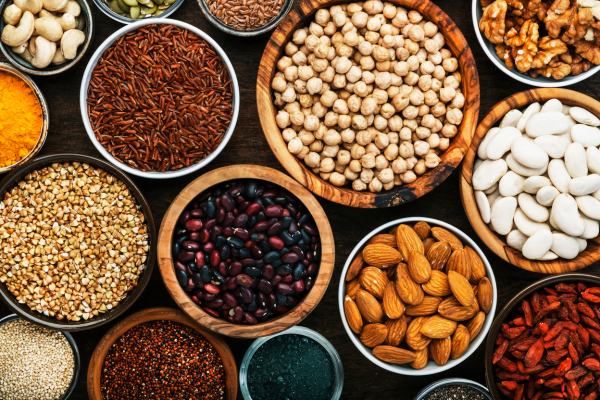Feeling like your diabetes diet is a bland routine? Look no further than the power of legumes! Beans, peas, and lentils aren’t just a delicious addition to your plate; they’re superstars for managing diabetes. This article unlocks the secrets of how these humble legumes can transform your health. Get ready to discover how legumes can help you!
What are Legumes?
Legumes are a type of plant species belonging to the Fabaceae family, which is also known as the pea, bean, or legume family. These plants are characterized by their edible seeds enclosed in pods. Legumes are an essential source of nutrition for humans and animals alike.
Common examples of legumes include:
- Beans: Including black beans, kidney beans, pinto beans, navy beans, and chickpeas (garbanzo beans).
- Peas: Including green peas, split peas, and sugar snap peas.
- Lentils: Such as green lentils, red lentils, brown lentils, and French lentils.
- Soybeans: Used to produce soy products like tofu, soy milk, tempeh, and edamame.
- Peanuts: Despite being classified as legumes botanically, peanuts are often grouped with nuts in culinary contexts due to their similar taste and nutritional profile.
The Nutritional Profile and Benefits of Legumes
Legumes are nutrient powerhouses, offering a wealth of essential nutrients vital for fostering your overall health and well-being. They are particularly rich in:
Fiber
Legumes serve as a valuable reservoir of dietary fiber, encompassing both soluble and insoluble types. This fiber content aids in maintaining digestive health, regulating blood glucose levels, and facilitating weight management.
Protein
Legumes represent a significant plant-based protein source, rendering them indispensable components of vegetarian and vegan dietary regimens. They contain varying amounts of protein, with some varieties, such as soybeans, providing exceptionally high levels.
Complex Carbohydrates
Legumes are low in simple sugars and rich in complex carbohydrates, which are digested slowly, providing sustained energy and aiding in stabilizing blood sugar levels.
Vitamins
Legumes abound with essential vitamins, encompassing folate, vital for DNA synthesis and cell division; vitamin B6, crucial for metabolism and nervous system function; and vitamin K, indispensable for blood clotting and bone health.
Minerals
Legumes boast ample amounts of minerals like iron, vital for oxygen transport in the blood; potassium, crucial for heart health and muscle function; and magnesium, essential for nerve and muscle function.
Phytonutrients
Legumes contain various phytonutrients, including flavonoids and polyphenols, which have antioxidant and anti-inflammatory properties and may offer additional health benefits.
Glycemic Index of Legumes
The glycemic index (GI) assesses the speed at which carbohydrate-containing food elevates blood sugar levels. Lower GI foods are metabolized and absorbed gradually, resulting in a gradual blood sugar increase. In contrast, higher GI foods prompt a rapid spike in blood sugar levels due to faster digestion and absorption.
Legumes typically have a low to moderate GI, which means they have a relatively gentle impact on blood sugar levels compared to other carbohydrate sources. Their elevated fiber and protein content contribute to this effect, as they decelerate the digestion and absorption process of carbohydrates.
Beans, a prominent member of the legume family, have been extensively studied for their impact on blood sugar levels. According to research cited in the study by Livesey (2008), beans have a low glycemic index (GI) ranging from 27-42% relative to glucose. Are beans good for diabetics? Yes, the study indicates that beans generally fall into the category of low to moderate GI foods. They are one of the healthiest legumes you can consume.
Practical Tips for Incorporating Legumes into the Diabetic Diet
Incorporating legumes into your diabetic diet can be both nutritious and delicious with the right approach. Here are some practical tips to help you make the most of legumes in your meals and snacks:
- Mix and match different types of legumes in your dishes to provide yourself with a rich blend of textures and tastes. Additionally, consider incorporating legumes into snacks, such as roasted chickpeas or lentil-based crackers, to offer yourself convenient and satisfying options for between-meal munching.
- For beans and other legumes, consider soaking them overnight before cooking to shorten the cooking duration and improve their digestibility. Another efficient method for preparing them while preserving their nutrients and flavors is pressure cooking.
- Discover delicious recipes that showcase the versatility of legumes. Try bean and vegetable chili, a hearty mix of beans, lentils, and flavorful veggies. Opt for a refreshing quinoa salad with chickpeas, perfect for lunch or dinner. Enjoy warm and nourishing lentil soup simmered with aromatic vegetables and broth.
Pairing legumes with lean proteins, healthy fats, and non-starchy vegetables helps you create balanced meals that support stable blood sugar levels. Monitor your blood sugar response to different legumes, allowing yourself to adjust portion sizes accordingly, ensuring optimal dietary choices for blood sugar control.
By integrating these practical suggestions into your meal planning and preparation, you can relish the health benefits and culinary pleasures of legumes while effectively controlling your blood sugar levels.
Frequently Asked Questions (FAQs)
Are lentils good for diabetics?
Yes, lentils are an excellent choice for you due to their low GI, high fiber content, and protein-rich composition, which can help stabilize blood sugar levels and promote overall health.
Can diabetics eat chili?
Yes, you can enjoy chili as long as it’s prepared with lean protein sources like turkey or lean beef, plenty of vegetables, and minimal added sugars. Additionally, opting for chili recipes that include beans can provide additional fiber and protein to help manage blood sugar levels.
Are baked beans good for you?
Baked beans can be a nutritious complement to a balanced diet, as they are rich in fiber, protein, and essential nutrients, including iron and folate. However, when considering the healthiest beans to eat, it’s important to choose varieties with reduced sugar and sodium content and consume them in moderation as part of a well-rounded meal plan.


